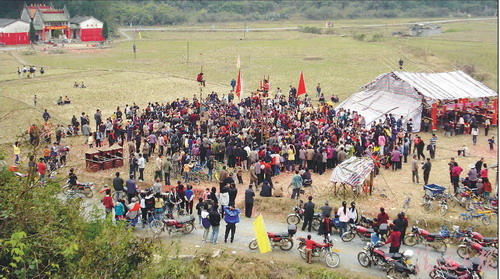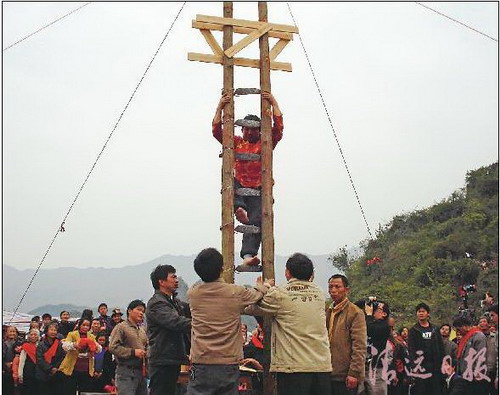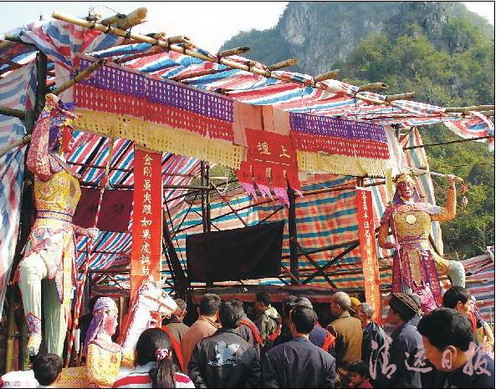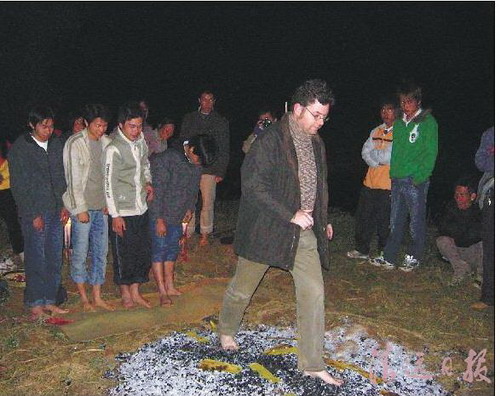The term jiao means "offering" or "sacrifice." It refers, in the present day, to the large-scale Taoist ceremonies organized by local communities, and by other social groups such as professional guilds and various forms of voluntary religious associations, in order to define themselves on the religious level, and specifically in order to establish or confirm the (semicontractual) relationship between the group and its tutelary deity. A jiao may be performed at intervals of three, five, or more years (depending on local traditions) as either a recurrent rite for renewing life and blessings for the community ("Offering of Thanksgiving and Praying for Peace," xie'en qi'an jiao), or a rite that responds to immediate problems such as drought or epidemics ("Offering for Averting Calamities," rangzai jiao).
A classical form of jiao (see table below) is typically headed by Taoist priests representing the Zhengyi tradition, though in some localities variant forms can be performed by priests of the more popular (and often resident), Red-head (hongtou) category. The event may last a week or longer, and invariably involves the whole community in festivities which include, for example, processions in which the statue of the deity is carried through the neighborhood, trance performances of mediums who become possessed by the god, performances by hired theatre troops on temporary stages, and large-scale presentations of offerings to the god in front of the local temple. The central part of the liturgical program in a classical Zhengyi jiao is performed by the priests (together with their troop of musicians) behind the closed doors of this temple and is witnessed only by select representatives of the community. The inside of the temple is rearranged for the occasion, the statue of the tutelary god being removed from the place of honor in the ritual north--which is now temporarily occupied by scrolls representing the supreme Taoist deities--and placed with its back against the closed door, in the position of worshipping these higher deities. The actual structure of the Taoist ritual area, referred to as the "Taoist altar" (daotan), thus bears out the Taoist vision of a cosmic hierarchy presided over by the Three Clarities (sanqing), such that the gods of the common Chinese religion (representing the postcelestial state, houtian) are viewed as deriving their authority from the higher Taoist powers (representing the precelestial state, xiantian).
Program of a three-day Offering (jiao) ritual. Based on Schipper, Le Fen-teng: Rituel taoïste, 10-11. For similar programs, see Lagerwey, Taoist Ritual in Chinese Society and History, 293, and Tanaka Issei, "The Jiao Festival in Hong Kong and the New Territories," 275-79.
| DAY 1 |
| 1 |
Announcement (fabiao) |
| 2 |
Invocation (qibai) |
| 3 |
Flag-Raising (yangqi) |
| 4 |
Noon Offering (wugong) |
| 5 |
Division of the Lamps (fendeng) |
| 6 |
Sealing the Altar (jintan) |
| 7 |
Invocation of the Masters and Saints (qi shisheng) |
| 8 |
Nocturnal Invocation (suqi) |
| DAY 2 |
| 9 |
Morning Audience (zaochao) |
| 10 |
Noon Audience (wuchao) |
| 11 |
Evening Audience (wanchao) |
| DAY 3 |
| 12 |
Renewed Invocation (chongbai) |
| 13 |
Presentation of the Memorial (jinbiao or baibiao) |
| 14 |
"Ten Thousand Sacred Lamps of the Three Realms" (sanjie wangling shengdeng) |
| 15 |
Orthodox Offering (zhengjiao) |
| 16 |
Universal Salvation (pudu) |
Photos of the Jiao Ritual conducted in Yingde city of Guangdong province in February 2010:
 |
| Local people gathered at the site for the Jiao Ritual. |
 |
| "Climb the sword mountain" |
 |
| Go up the altar |
 |
|
Zong Shuren, director of the Hong Kong Research Center of the France Institute of Far East Study, strides over the flames with the locals.
|